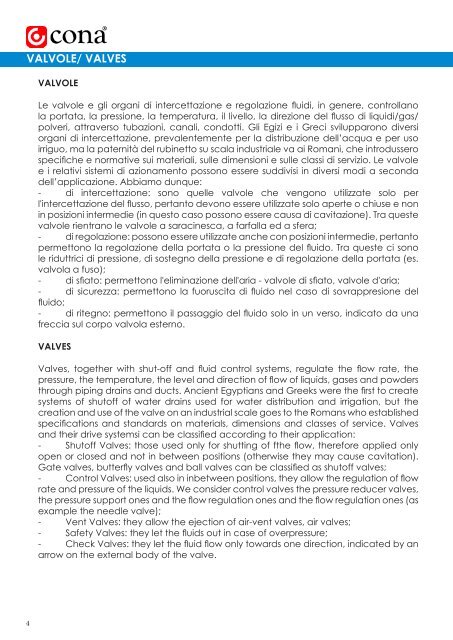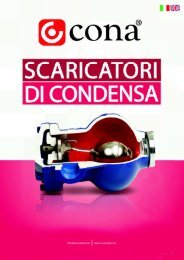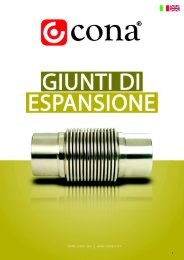Create successful ePaper yourself
Turn your PDF publications into a flip-book with our unique Google optimized e-Paper software.
VALVOLE/ VALVES<br />
VALVOLE<br />
Le valvole e gli organi di intercettazione e regolazione fluidi, in genere, controllano<br />
la portata, la pressione, la temperatura, il livello, la direzione del flusso di liquidi/gas/<br />
polveri, attraverso tubazioni, canali, condotti. Gli Egizi e i Greci svilupparono diversi<br />
organi di intercettazione, prevalentemente per la distribuzione dell’acqua e per uso<br />
irriguo, ma la paternità del rubinetto su scala industriale va ai Romani, che introdussero<br />
specifiche e normative sui materiali, sulle dimensioni e sulle classi di servizio. Le valvole<br />
e i relativi sistemi di azionamento possono essere suddivisi in diversi modi a seconda<br />
dell’applicazione. Abbiamo dunque:<br />
- di intercettazione: sono quelle valvole che vengono utilizzate solo per<br />
l'intercettazione del flusso, pertanto devono essere utilizzate solo aperte o chiuse e non<br />
in posizioni intermedie (in questo caso possono essere causa di cavitazione). Tra queste<br />
valvole rientrano le valvole a saracinesca, a farfalla ed a sfera;<br />
- di regolazione: possono essere utilizzate anche con posizioni intermedie, pertanto<br />
permettono la regolazione della portata o la pressione del fluido. Tra queste ci sono<br />
le riduttrici di pressione, di sostegno della pressione e di regolazione della portata (es.<br />
valvola a fuso);<br />
- di sfiato: permettono l'eliminazione dell'aria - valvole di sfiato, valvole d'aria;<br />
- di sicurezza: permettono la fuoruscita di fluido nel caso di sovrappresione del<br />
fluido;<br />
- di ritegno: permettono il passaggio del fluido solo in un verso, indicato da una<br />
freccia sul corpo valvola esterno.<br />
VALVES<br />
Valves, together with shut-off and fluid control systems, regulate the flow rate, the<br />
pressure, the temperature, the level and direction of flow of liquids, gases and powders<br />
through piping drains and ducts. Ancient Egyptians and Greeks were the first to create<br />
systems of shutoff of water drains used for water distribution and irrigation, but the<br />
creation and use of the valve on an industrial scale goes to the Romans who established<br />
specifications and standards on materials, dimensions and classes of service. Valves<br />
and their drive systemsi can be classified according to their application:<br />
- Shutoff Valves: those used only for shutting of fthe flow, therefore applied only<br />
open or closed and not in between positions (otherwise they may cause cavitation).<br />
Gate valves, butterfly valves and ball valves can be classified as shutoff valves;<br />
- Control Valves: used also in inbetween positions, they allow the regulation of flow<br />
rate and pressure of the liquids. We consider control valves the pressure reducer valves,<br />
the pressure support ones and the flow regulation ones and the flow regulation ones (as<br />
example the needle valve);<br />
- Vent Valves: they allow the ejection of air-vent valves, air valves;<br />
- Safety Valves: they let the fluids out in case of overpressure;<br />
- Check Valves: they let the fluid flow only towards one direction, indicated by an<br />
arrow on the external body of the valve.<br />
4





